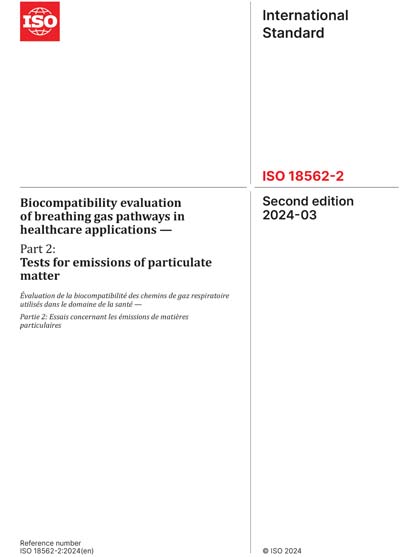Most recent
ISO 18562-2:2024
Biocompatibility evaluation of breathing gas pathways in healthcare applications - Part 2: Tests for emissions of particulate matter
This document specifies tests for the emissions of particulate matter from the gas pathways of a medical device, its parts or accessories, which are intended to provide respiratory care or supply substances via the respiratory tract to a patient in all environments. The tests of this document are intended to quantify particles from 0,25 µm diameter to 10 µm diameter that are emitted by the medical device, its parts or accessories into the respirable gas stream. This document establishes acceptance criteria for these tests.
This document does not address nanoparticles. Insufficient data exist to establish exposure limits for particles less than 0,25 µm diameter.
This document does not address particles larger than 10 µm diameter. These particles are deposited in the nasal cavity. Additional information can be needed for medical devices or accessories that bypass the nose. This is outside the scope of this document but can be required by some authorities having jurisdiction.
This document therefore adopts the same approach as the US Environmental Protection Agency (EPA) in setting limits based solely on particle size and not their chemistry.
This document addresses potential contamination of the gas stream arising from the gas pathways, which is then conducted to the patient.
This document applies over the expected lifetime of the medical device in normal use and takes into account the effects of any intended processing.
This document does not address biological evaluation of the particles that are deliberately released by a nebulizer (i.e. the therapeutic agent).
This document does not address biological evaluation of the surfaces of gas pathways that have direct contact with the patient. The requirements for direct contact surfaces are found in the ISO 10993 series.
Medical devices, parts or accessories, containing gas pathways that are addressed by this document, include, but are not limited to, ventilators, anaesthesia workstations (including gas mixers), breathing systems, oxygen conserving devices, oxygen concentrators, nebulizers, low-pressure hose assemblies, humidifiers, heat and moisture exchangers, respiratory gas monitors, respiration monitors, masks, medical respiratory personal protective equipment, mouth pieces, resuscitators, breathing tubes, breathing systems filters, Y-pieces, and any breathing accessories intended to be used with such devices. The enclosed chamber of an incubator, including the mattress, and the inner surface of an oxygen hood are considered to be gas pathways and are also addressed by this document.
This document does not address contamination already present in the gas supplied from the gas sources while medical devices are in normal use.
EXAMPLE Contamination arriving at the medical device from gas sources such as medical gas pipeline systems (including the non-return valves in the pipeline outlets), outlets of pressure regulators connected or integral to a medical gas cylinder or room air taken into the medical device is not addressed by ISO 18562 (all parts).
International Organization for Standardization [iso]

